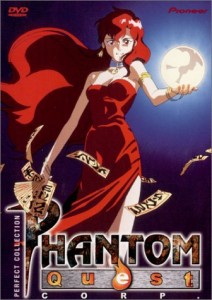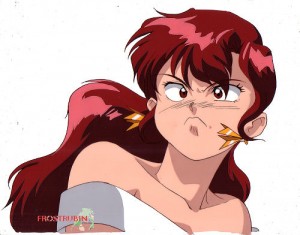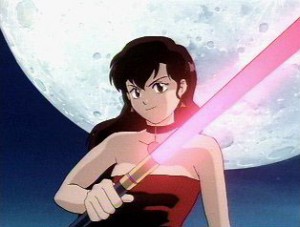Yūgen Kaisha (Phantom Quest Corporation), directed by Koichi Chigira, Morio Asaka, and Takuji Endo. Four 30–minute episodes. August 25, 1994 – February 25, 1995.
 This didn’t seem to be a forgotten OAV series. It was four half-hour “incident files”, released every two months (August 25, October 25, and December 25, 1994, and February 25, 1995) by Pioneer LDC, then in English on two two-episode VHS videos and laser discs on April 27 and June 27, 1995, and finally as a single Perfect Collection DVD on August 22, 2000. (The Japanese company later changed its name to Geneon Entertainment, dropped out of the American anime market, underwent further evolution, and is now the English-named NBCUniversal Entertainment Japan. To digress, all this almost affected me personally. I was writing two monthly columns for A.D.Vision’s prestigious monthly anime magazine, Newtype USA, at the time of my massive stroke in March 2005. By the time I went through rehabilitation therapy, improved enough to be moved into a convalescent hospital, and tried to reestablish my old contacts, Newtype USA had ceased publication. It turned out the magazine had never depended upon sales to anime fans for its profitability. It was heavily dependent upon advertising revenue from the anime DVD companies, which by 2005 were dominated by the giant Geneon. When Geneon abruptly ceased its American anime DVD marketing and stopped advertising in Newtype USA, the magazine became unprofitable and A.D.V. killed it.) The animation studio for Pioneer was Madhouse. Pioneer also released two music albums, a Japanese light novel, and – while Pioneer/Geneon was trying to break into the American market – one issue of an English-language comic book.
This didn’t seem to be a forgotten OAV series. It was four half-hour “incident files”, released every two months (August 25, October 25, and December 25, 1994, and February 25, 1995) by Pioneer LDC, then in English on two two-episode VHS videos and laser discs on April 27 and June 27, 1995, and finally as a single Perfect Collection DVD on August 22, 2000. (The Japanese company later changed its name to Geneon Entertainment, dropped out of the American anime market, underwent further evolution, and is now the English-named NBCUniversal Entertainment Japan. To digress, all this almost affected me personally. I was writing two monthly columns for A.D.Vision’s prestigious monthly anime magazine, Newtype USA, at the time of my massive stroke in March 2005. By the time I went through rehabilitation therapy, improved enough to be moved into a convalescent hospital, and tried to reestablish my old contacts, Newtype USA had ceased publication. It turned out the magazine had never depended upon sales to anime fans for its profitability. It was heavily dependent upon advertising revenue from the anime DVD companies, which by 2005 were dominated by the giant Geneon. When Geneon abruptly ceased its American anime DVD marketing and stopped advertising in Newtype USA, the magazine became unprofitable and A.D.V. killed it.) The animation studio for Pioneer was Madhouse. Pioneer also released two music albums, a Japanese light novel, and – while Pioneer/Geneon was trying to break into the American market – one issue of an English-language comic book.
Nevertheless, while Phantom Quest Corporation was favorably reviewed at the time and isn’t entirely forgotten today, it is out-of-print currently. And there is evidence that for all its apparent popularity, it was originally intended to run at least six OAVs before Pioneer discontinued it after #4. The episodic story breaks off abruptly and with no final resolution. Co-director Morio Asaka has said that he expected it to last long enough to resolve the romantic relationship between Ayaka and police Lieut. Karino.
The title was whatever the Japanese equivalent of a pun is using different same-pronunciation kanji characters. “Yūgen Kaisha” in Japanese means “Limited Liability Company”. But “yūgen” written with different kanji pronounced the same means “the occult”, and the “kai” of “kaisha” written with different kanji means “mysterious”. “-sha” means company. So “Yūgen Kaisha” written differently in Japanese means “the occult/phantom/ghost mystery company”. As you can tell from all this, the series was as comedic as it was mysterious.
Ayaka Kisaragi is the latest descendant in a long line of Japanese supernatural exorcists. She decides to become a modern businesswoman and sets up Yūgen Kaisha as a company to help those who need paranormal aid, in the old Kisaragi home in today’s Shinjuku commercial/administrative district of Tokyo. Her freelance staff consists of Mamoru Shimesu, a live-in young boy computer genius (yes, his name is also a pun); Madame Suimei, an elderly fortune-teller, usually smiling but ruthless about demanding payment in advance; Nanami Rokugo, a demure teenage girl who controls a fire elemental; and Rokkon, a traditional Shinto priest/exorcist. They are also aided by klutzy police lieutenant Kozo Karino who, when a case seems to involve the occult, asks for Yūgen Kaisha’s help. The series seemed to be developing a subplot about a romance between Ayaka and Kozo when it was discontinued.
 The company was not only started by Ayaka Kisaragi, she leads all of its investigations personality and impulsively. She has developed the high-tech anti-monster weapons of an apparent lipstick that turns into a laser exorcist’s spell, and earrings that contain supernatural energy. Unfortunately, Ayaka’s impulsiveness also undercuts all of the company’s successes. Every time she collects for a successful case, she goes on a shopping binge, gets drunk, and sings karaoke loudly. A running gag at the beginning of each episode is Ayaka’s determination to sleep in late after all-night revelry, and Mamoru’s increasing ploys to get her up.
The company was not only started by Ayaka Kisaragi, she leads all of its investigations personality and impulsively. She has developed the high-tech anti-monster weapons of an apparent lipstick that turns into a laser exorcist’s spell, and earrings that contain supernatural energy. Unfortunately, Ayaka’s impulsiveness also undercuts all of the company’s successes. Every time she collects for a successful case, she goes on a shopping binge, gets drunk, and sings karaoke loudly. A running gag at the beginning of each episode is Ayaka’s determination to sleep in late after all-night revelry, and Mamoru’s increasing ploys to get her up.
In Incident File 01, “Kiss of Fire”, seen here with great English voice acting (ugh!), Tokyo is being terrorized by a vampire who may be Count Dracula (or “Draculra”, the Japanese playing safe by including both a l and a r), himself. Bodies are being found drained of blood. The Ambassador of Transylvania tells Yūgen Kaisha that, during Japan’s famous “bubble prosperity” (the late 1980s to 1991), a rich Japanese investor bought Transylvania’s national treasures and had them shipped to Tokyo. Including Dracula’s casket. Still occupied. By the time Transylvania’s diplomats had found it, the casket was empty. The Ambassador offers Ayaka any price to catch Dracula.
Ayaka learns from Madame Suimei that Dracula’s next bride is 19-year-old Makiko Mizuhara. Ayaka stakes out Makiko’s apartment at night and when Dracula appears, she jumps out to fight him with her lipstick exorcist light saber and her earring bombs. Dracula gets away. She trails him – or another vampire — all night into the next day; but vampires aren’t supposed to be out during the day. She tracks him to the “Tea Room Transylvania”, a dainty tea shoppe whose young-girl clientele refer to Ayaka as “an older girl” (which she takes as an insult), and where Makiko is a waitress. The tea room barrista is a vampire, but an anemic one who pleads innocent – he’s been trying to wean himself away from blood, taking ultraviolet tanning sessions, gradually getting used to crosses and garlic. But he still needs some blood — 200 c.c.’s four times a year. And “the blood must be of the purest kind. A girl who’s a virgin, doesn’t drink or smoke or do drugs – a girl like that in this century is almost impossible to find.” Makiko has been voluntarily giving her blood to him, but Dracula wants it all, right away. The good vampire joins Ayaka in tracking Dracula to the top of Tokyo Tower.
 In the climactic battle atop Tokyo Tower, the Phantom Quest Corp. finally defeats Dracula – but the Tower is so damaged that the repair bill, even after Transylvania’s “any price” payment, leaves them deep in the red again.
In the climactic battle atop Tokyo Tower, the Phantom Quest Corp. finally defeats Dracula – but the Tower is so damaged that the repair bill, even after Transylvania’s “any price” payment, leaves them deep in the red again.
In Incident File 02, “End of the World”, a drunken Ayaka is singing karaoke in a taxi when she senses supernatural danger as they pass the Asama Hospital. She grabs the taxi’s steering wheel and causes a minor crash, but avoids a bigger highway disaster just ahead. The taxi driver, Mr. Sano, suffers a minor shoulder injury and is taken to the nearby hospital; but when Ayaka visits the Asama Hospital the next day, he is dead. Ayaka and Mamoru investigate the hospital in disguise, and find that Lieut. Karino is also investigating; the Asama Hospital has had too many mysterious deaths recently. They learn that the hospital’s director/head doctor has made a deal to be possessed by a poltergeist/demon that has been causing accidents nearby to get patients that it, as the surgeon, can kill; for their life force for the poltergeist, and for the victim’s organs that the doctor can illegally sell. Ayaka, Mamoru, and Kozo are chased through the hospital by the poltergeist when they try to save its latest victim, schoolgirl Nanami Rokugo; but she turns out to be the Phantom Quest Corp.’s latest freelancer with a psychic talent of her own. The poltergeist is defeated, and Nanami becomes a full member of the Phantom Quest Corp. team.
 In Incident Report 03, “Love Me Tender”, the large Nakasugi Department Store is holding an Ancient Sahara Exhibit of recently discovered archaeological finds, including mummies. The exhibit is supposedly cursed and brings bad luck into the store. Arrogant director Toru Nakasugi doesn’t believe in the supernatural, but he hires the Phantom Quest Corp. as a publicity stunt to investigate and assure his staff and the public that the exhibit is supernatural-free. Madame Suimei agrees that there is no curse, but she privately tells Ayaka that the bad luck is real and is being caused by a ghost within the exhibit. Ayaka goes to exorcise the ghost, but finds that it is of Higashi Narita, the young Japanese archaeologist who died discovering the ruins. He is bound to them and has been brought back to Japan with them, but he is causing the bad luck to try to protect the young exhibit curator, Natsugi Ogawa, who was his fiancée, from director Nakasugi’s advances. Ayaka stops Narita from killing Nakasugi when he forces himself upon Natsugi , but does not otherwise prevent him from rescuing her. Nakasugi is removed by the department store’s other management, the exhibit is a success to Natsugi’s credit, and Narita’s ghost can ascend to Heaven. But Nakasugi’s removal from authority means that the Phantom Quest Corp. will not be paid.
In Incident Report 03, “Love Me Tender”, the large Nakasugi Department Store is holding an Ancient Sahara Exhibit of recently discovered archaeological finds, including mummies. The exhibit is supposedly cursed and brings bad luck into the store. Arrogant director Toru Nakasugi doesn’t believe in the supernatural, but he hires the Phantom Quest Corp. as a publicity stunt to investigate and assure his staff and the public that the exhibit is supernatural-free. Madame Suimei agrees that there is no curse, but she privately tells Ayaka that the bad luck is real and is being caused by a ghost within the exhibit. Ayaka goes to exorcise the ghost, but finds that it is of Higashi Narita, the young Japanese archaeologist who died discovering the ruins. He is bound to them and has been brought back to Japan with them, but he is causing the bad luck to try to protect the young exhibit curator, Natsugi Ogawa, who was his fiancée, from director Nakasugi’s advances. Ayaka stops Narita from killing Nakasugi when he forces himself upon Natsugi , but does not otherwise prevent him from rescuing her. Nakasugi is removed by the department store’s other management, the exhibit is a success to Natsugi’s credit, and Narita’s ghost can ascend to Heaven. But Nakasugi’s removal from authority means that the Phantom Quest Corp. will not be paid.
In Incident Report 04, “Lover, Come Back to Me”, Ayaka and Rokkon are chasing a werewolf when they come upon a group of Buddhist monks led by their priest, Mukyo. The monks quickly vanquish the werewolf. They are Hadja, an esoteric Buddhist offshoot that specializes in demon exorcism, and they have come to Tokyo to battle its demons. In the coming weeks, they always beat Ayaka to a plague of demons, and their TV advertisements get them all the exorcism business. Ayaka, Mamoru, and Nanaki are forced to take jobs as waitresses and kitchen help at the local Hamm-Hamm coffee shop. (Its mascot/emblem is a cartoon hamster.) Lieut. Karino suspects something about the sudden plague of demons, goes to investigate Hadja in their new headquarters, and disappears. The whole Phantom Quest Corp. team goes to find him. They discover that Mukyo is controlling all the supernatural monsters that are terrorizing Tokyo, and that Hadja defeats so easily. The climax is a rooftop duel between Ayaka with her lipsick light saber, and Mukyo with his priest’s staff. It ends with Kozo rescuing Ayaka. (This ending would presumably have been developed into the romance that Morio Asaka alluded to.)
One of the most popular features of Phantom Quest Corp. was its sultry and jazzy opening and closing theme songs. The English versions, titled “Blue Devil Blues” and “Dancin’ With a Demon”, were heard in karaoke versions at the new anime fan conventions for the next several years. Ayaka was popular with feminine cosplayers, too.
Next week: a break from Japanese OAVs for my 3rd anniversary of Funny Animals and More.


 Fred Patten (1940-2018) was an internationally respected comics and animation historian. He has written about anime or comic books for publications ranging from Animation Magazine and Alter Ego to Starlog. He was a contributor to The Animated Movie Guide (2005), and is author of Watching Anime, Reading Manga (2004, Stone Bridge Press), a collection of his best essays, and Funny Animals and More (2014, Theme Park Press), based upon his early columns here on Cartoon Research. He passed away on November 12th, 2018.
Fred Patten (1940-2018) was an internationally respected comics and animation historian. He has written about anime or comic books for publications ranging from Animation Magazine and Alter Ego to Starlog. He was a contributor to The Animated Movie Guide (2005), and is author of Watching Anime, Reading Manga (2004, Stone Bridge Press), a collection of his best essays, and Funny Animals and More (2014, Theme Park Press), based upon his early columns here on Cartoon Research. He passed away on November 12th, 2018.





































It was quite a short ride when Pioneer was pretty dead set on bringing these titles to the US anyway possible. I kinda miss it.
Now you see why I’m not a fan anymore! Of course most would tell you NewType is essentially “Press Release: The Magazine” but we fell for it.
Forgot they had them when I was more used to AIC’s output Pioneer also released.
Pioneer was pretty good about creating English language versions of these tunes like they did with Tenchi Muyo. Thinking of more forgotten Pioneer titles, Kishin Corps comes to my mind (produced by AIC). Never watched that one, but this podcast from a decade back pretty much let me know what to expect if I had.
http://www.awopodcast.com/2006/12/anime-world-order-show-43-hey-sanrio.html
The same people only recently got around to doing one for El Hazard: The Magnificent World (also being forgotten, but shouldn’t really).
The American equivalent of “Newtype”, roughly speaking, is “Animation Magazine”. Its articles are all thinly-disguised totally uncritical studio press releases. We loved “Newtype” anyway for its superior graphics, tailor-made for the American anime fan who can’t read Japanese.
I am trying to decide whether to limit these “forgotten” OAVs to single-video titles, or to include the four- and six-episode titles like “Kishin Corps”, “Pirates Are the Enemy” (I never accepted the translation of “The Pirate is the Enemy”), and this “Phantom Quest Corp.” What would people prefer?
I don’t mind which direction you prefer to go, though nobody else has chimed in with their opinions though.
The number of issues of Animation Magazine I did pick up make me think it was more a standard trade publication, what with the ads for distributors and studios I never thought to write to. At least it gave me something to look forward to 20 years ago.